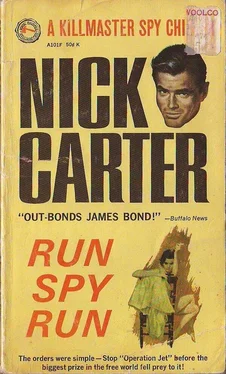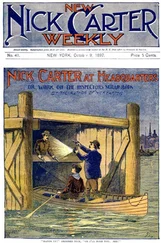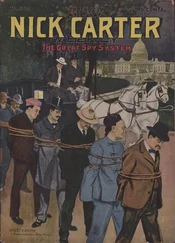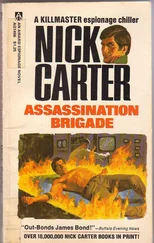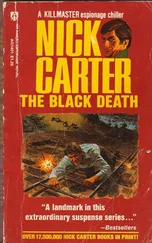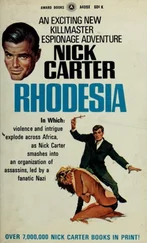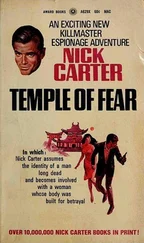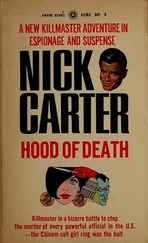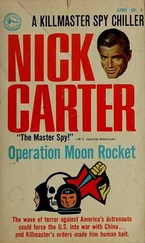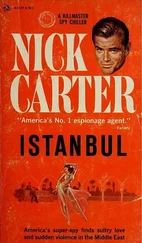Nick opened his Liggett's bag, empty of all but his briefcase and its welcome contents, and took out the flask.
Glass in hand, he settled down to inspect Hawk's present. Wilhelmina, Hugo and Pierre had taken the parcel's place on the bed.
The bulging wallet contained a number of cards, licenses and memoranda that would all need memorizing. A résumé informed him that Peter Cane was an instructor at an Ivy League college, a young man with an apparently great future in archaeology. It was just as well he'd been in on that Bahrein expedition, he reflected, or he'd have had more studying to do than he could handle. But Hawk had counted on Nick's past experience to help him with the present. The rest of the information on Peter Cane dealt with his background, his personality, and his family history. The letter from the girl, hinting at a touch of gentlemanly restraint and possibly shyness in his character, fitted in nicely.
A hundred and fifty dollars in cash rounded out the contents of the wallet. A separate envelope revealed a thousand dollars in traveler's checks for Peter Cane, and a neat, satisfying pile of fives, tens and twenties for Nick Carter. The total budget was over five thousand dollars. Nick riffled the bills. Automatically, he split the pack and began worrying the bills into creases and folds to take away some of the newness. He had no intention of spreading them around in the guise of Peter Cane, underpaid instructor, but if he did have to dip into the reserve fund he certainly wasn't going to flash wads of brand new money.
The blue address book was filled with names, phone numbers and street addresses of people in places like New Haven, Princeton, Bennington, and so on. Most of them were male and clearly in the academic field. A sprinkling of feminine names relieved the New York area. And there was his sister's address in Yellow Springs. How very homey.
The pressboard binder with the stack of typewritten sheets was the next item to command his attention. He read swiftly but with care:
LORD EDMOND BURNS. Labor Leader, Great Britain. Died June 1, 1963. English Atlantic coast. Crash shortly after takeoff of World Airways plane. Seventy-nine killed. Explosion of undetermined origin. Suspicion of pilot error proved unfounded. Evidence of behind-scenes meddling. See below. Burns replaced by Jonathan Welles, well known for sympathies with Red Chinese.
AHMED TAL BARIN. Pacifist-Neutralist, India. Died July 13, 1963. Pacific Ocean, U.S. Orienta Airlines plane exploded, killing sixty-seven. Cause unproven. Indian Pacifist faction led by Tal Barin now being swayed by supporters of Red Chinese.
AUGUSTO LA DILDA. Lola Party President, Peru. Died August 6, 1963. North Africa. Afro-American Airlines turboprop exploded and crashed. Thirty-seven dead. Explosion blamed on individual sending bomb on board in father's suitcase for insurance benefits. Moderate Lola Party dissolved, reformed; now believed sympathetic to Red Chinese influences in Peru.
PABLO VALDEZ. Cabinet Secretary, Minirio. Died September 3, 1963. Idlewild Airport, New York City, N.Y. Explosion on field killed eleven. Cause undetermined. Minirio increasingly subjected to Communist Chinese infiltration in recent months. Government now in state of chaos. Successor to Valdez not yet named.
The bulk of the file contained dossiers and reports from CAB, eyewitnesses, foreign authorities and airline officials; reports from the insurance companies connected with the wrecks, giving details of the various claims made by relatives; and the complete biographies of the first three diplomats involved. There were one or two gaps in the story of Valdez, but that was to be expected under the circumstances. No doubt more information would soon be available.
The one glaring, inescapable fact was that four men had died in airplane tragedies — four men who had held positions of power that the Red Chinese might be exceedingly happy to see vacated. Each man had stood in the way of some kind of Red Chinese power grab.
Surely not coincidence but master plan.
British officialdom, as a result of Hawk's personal call, had conceded that their conviction of pilot error in the case of the World Airways crash had been bolstered by the bottle-littered condition of the pilot's apartment, discovered after an anonymous tip; that the pilot's fiancée, Miss Rita Jameson, had repeatedly insisted that pilot Anderson was moderate in habit, had spent the early part of the evening with her and retired chastely for the night; that they had discounted her story, believing it to be the natural loyalty of a woman in love; that Miss Jameson had persisted in attempts to re-open the investigation; that she had received a politely worded official letter asking her discreetly to refrain from further enquiry, as her actions were an embarrassment and a hindrance to the investigating authorities, who had indeed not closed the case; and that, after waiting for some time to be further questioned or informed, Miss Jameson had discussed this letter with the authorities and all parties concerned had then realized that the communication was a forgery, designed, apparently, to forestall further interference. However, new evidence had come to light as a result of the continued investigation, and authorities agreed that it would be impolitic to encourage Miss Jameson's interest. The new facts being so appalling in their implications and the spuriousness of the letter suggesting something so sinister, it was felt that every effort should be made to pursue the inquiry in absolute secrecy, and that Miss Jameson should be advised to leave matters in the hands of the experts. She was also to be left with the impression that, the letter notwithstanding, they had as yet had no reason to ascribe the crash to any cause other than that already suggested.
In other words, Rita had been given the brush-off and forced to turn elsewhere for help.
The individual accused of planting a bomb on board the Afro-American Airlines plane via his father's suitcase had insisted that his father had himself suggested that heavy insurance be taken out, and that he, the son, had had no access to his father's suitcase for days before the crash, had not even been aware of the flying schedule. All those questioned in connection with insurance claims had similar stories. In fact, the authorities had all but given up the possibility of murder-for-insurance, but had allowed the public to go on believing in it since no other official theories could be made available.
Into the AXE files had come the story of each of the disasters as they had occurred. To Hawk's inquiring mind they had suggested a pattern. Consultation with other federal intelligence agencies had determined that AXE, the trouble-shooting arm of the cooperating services, would spearhead an investigation based on the possibility of international sabotage.
As to local events, a brief report revealed no conclusive link between the explosions and the attacks on Carter and Rita Jameson, but strongly supported Nick's own belief that each incident formed part of the same picture. The cablegram certainly provided a tie between Rita, Nick, and Flight 16, if not conclusively between that flight and the three previous disasters. As for A. Brown of 432A East 86th Street, he was apparently an infrequent user of a sparsely furnished walk-up apartment at that address, checking in daily for mail and messages but seldom sleeping there. Agents had staked out the place but were doubtful that their quarry would show. A description had, however, been obtained from the landlady and fingerprints had been lifted from various surfaces in apartment 4G.
Investigation of all facets of the situation was still under way. Further information was expected — Nick read on to the end.
So far, what they had was four dubious plane disasters and four dead diplomats. But Senor Valdez and his steel hand just didn't quite fit into the pseudo-accidental pattern of insurance schemes and pilot errors, of greedy relatives and lethal suitcases and inexplicable baggage tags. Senor Valdez had blown himself up, not by choice and almost certainly with his steel hand. How had that been accomplished, and by whom? Where did such a bizarre circumstance fit into the pattern presented by the first three catastrophes?
Читать дальше
